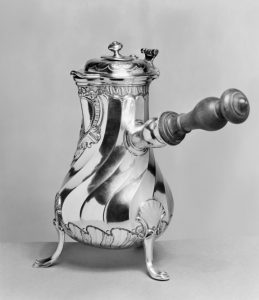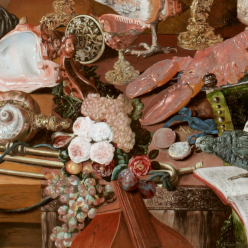
Joseph-Théodore Van Cauqenbergh, Paris, France 1774
Silver, aramanth wood
Walters Art Museum, Baltimore, Maryland.
Van Cauqenbergh, Joseph-Théodore. Chocolate Pot. 1774. Silver, aramanth wood. Walters Art Museum, Baltimore, Maryland. 1948. https://art.thewalters.org/detail/5934/chocolate-pot/.
Provenance: John Alfonse Walter, Aux Cayes, Haiti, prior to 1793, [mode of acquisition unknown] [1827 inventory]; Susan Rodgers (wife of John Alfonse Walter), Baltimore [date of acquisition unknown], by inheritance; Laura Walter, Baltimore [date of acquisition unkown], by inheritance; Ethel R. Gray, Baltimore, 1911, by inheritance; Walters Art Museum, 1948, by purchase.
Cacao is a bean crop grown on trees and the fundamental basis for chocolate production. Europeans arriving in the New World found indigenous people to be consuming chocolate most commonly in the form of a drink with froth, and when the newcomers began to explore its additional uses, they created foodstuffs and even medication. The natives created chocolate by roasting and skinning the cacao beans, then crushing and grinding them to produce a more malleable substance, often adding other natural substances such as vanilla or honey for an improved taste.
Cacao played a vital cultural role in the lifestyle of native Americans, such as the Mayans and Aztecs. Archaeological research revealed engravings in ceremonial clay bowls of deities associated with the crop, and chocolate’s linguistic origin actually traces back to a phrase about the food of the god’s.
The European settlers saw much more commercial than religious potential in cacao, and word and taste of chocolate quickly spread across the continents. Thousands of pounds of the it were shipped to Europe, where the English eventually combined it with milk, liquor, and other ingredients. The manufacturing process involved the cleaning, roasting, cracking, and fanning of cacao beans, followed by their grinding and mixture with the prepared accompanying ingredients; the work required was quite manual and similar to that done by the native Americans with whom they found it. In Europe, this work was assisted by early manufacturing machinery, such as heated cauldrons, surfaces, mortars, and surfaces.
In the late 17th century, France’s consumption of chocolate, particularly by royalty, was common knowledge. The Siamese queen sent gifts of two silver chocolatiérs and five chocolate-pots, one of which was entirely gold, to Louis XIV. These grandiose presents served as models for equipment that soon became used all over Europe and even in British American colonies. The image above shows a later design of the instrument gifted to Louis XIV, the silver chocolatiére.
The transport and spread of chocolate resulted in its eventual development into a social symbol. In European countries such as Spain and Italy, it was consumed largely by those of upper and religious class. It was used in artwork as an indicator of social elevation, particularly in situations where it was being served by a foreign servant, which historical perspective can attribute to the crop’s close connection with imperialism.
Chocolate’s presence further generated something of a social stereotype surrounding women. This was rooted in its consumption by nuns and the European priests’ condemnation of it because of the financial expense; however, chocolate later became a symbol of female malignance in general. Its association with witchcraft became a widespread idea; it was said to be used in love potions, with other key ingredients such as menstrual blood. This social link was solidified on a higher, more legal level by Inquisition allegations of the creation of such potions.
Sources:
Bonnart, Robert. Un cavalier et une dame buvant du chocolat. 1718. Engraved maunuscript. BnF, Department of Manuscripts, CLAIRAMBAULT 503, National Library of France. Accessed October 9, 2018. http://classes.bnf.fr/essentiels/grand/ess_1558.htm.
Coe, Sophie D. et al. The True History of Chocolate. United Kingdom: Thames and Hudson, 1996.
Earle, Rebecca. The Body of the Conquistador: Food, Race, and the Colonial Experiences in Spanish America, 1492-1700. Cambridge, UK: Cambridge University Press, 2013.

